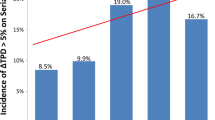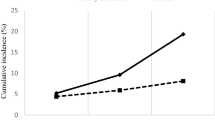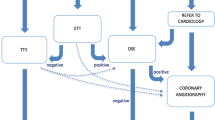Abstracts
Background
An AHA/ACCF scientific statement proposed 8 risk factors to assess the need for noninvasive coronary artery disease (CAD) surveillance in asymptomatic patients undergoing evaluation for kidney transplantation. The clinical application of these risk factors and the role of noninvasive testing in this context have not been defined.
Methods and Results
We retrospectively followed a cohort of 581 consecutive kidney transplant recipients of whom 401 had pre-transplant radionuclide myocardial perfusion imaging (MPI) and 90 had pre-transplant coronary angiography. The sum of pre-transplant AHA/ACCF risk factors (age >60 years, hypertension, diabetes, cardiovascular disease, dyslipidemia, smoking, dialysis >1 year, left ventricular hypertrophy) was calculated. MPI scans were analyzed by a “blinded” reader. Patients were followed for a mean of 3.7 ± 2.3 years post-transplant for major adverse cardiac events (MACE), defined as cardiac death or non-fatal myocardial infarction. The sum of risk factors was associated with modest discriminatory capacity for obstructive angiographic CAD (area under the curve [AUC], 0.70; P = 0.004), 30-day post-operative MACE (AUC, 0.60; P = 0.036), and long-term MACE (AUC, 0.63; P < 0.001). A threshold of ≥3 risk factors was optimal for identifying patients at risk. MPI provided incremental predictive value for obstructive CAD (P = 0.02) and long-term MACE (P = 0.04) but not post-operative MACE (P = 0.56). MPI was best predictive of long-term MACE in intermediate risk (3-4 risk factors) patients.
Conclusions
Asymptomatic kidney transplant candidates with ≥3 AHA/ACCF risk factors are at increased cardiac risk, and should be considered for noninvasive CAD surveillance. Intermediate risk patients (3-4 factors) benefit the most from pre-transplant MPI to define long-term MACE risk.




Similar content being viewed by others
Abbreviations
- ACCF:
-
American College of Cardiology Foundation
- AHA:
-
American Heart Association
- AUC:
-
Area under the curve
- CAD:
-
Coronary artery disease
- CI:
-
95% Confidence interval
- CVD:
-
Cardiovascular disease
- HR:
-
Hazard ratio
- KDOQI:
-
Kidney disease outcomes quality initiative
- MACE:
-
Major adverse cardiac events
- MPI:
-
SPECT myocardial perfusion imaging
References
United States Renal Data System. USRDS 2013 Annual Data Report: Atlas of chronic Kidney disease and end-stage renal disease in the United States. Bethesda, MD; 2013.
Port FK, Wolfe RA, Mauger EA, Berling DP, Jiang K. Comparison of survival probabilities for dialysis patients vs cadaveric renal transplant recipients. JAMA 1993;270:1339-43.
Arend SM, Mallat MJ, Westendorp RJ, van der Woude FJ, van Es LA. Patient survival after renal transplantation; more than 25 years follow-up. Nephrol, Dial, Transplant 1997;12:1672-9.
Aakhus S, Dahl K, Wideroe TE. Cardiovascular disease in stable renal transplant patients in Norway: Morbidity and mortality during a 5-yr follow-up. Clin Transplant 2004;18:596-604.
Wolfe RA, Ashby VB, Milford EL, Ojo AO, Ettenger RE, Agodoa LY, et al Comparison of mortality in all patients on dialysis, patients on dialysis awaiting transplantation, and recipients of a first cadaveric transplant. N Engl J Med 1999;341:1725-30.
Collins AJ. Cardiovascular mortality in end-stage renal disease. Am J Med Sci 2003;325:163-7.
Ojo AO, Hanson JA, Wolfe RA, Leichtman AB, Agodoa LY, Port FK. Long-term survival in renal transplant recipients with graft function. Kidney Int 2000;57:307-13.
Kasiske BL, Maclean JR, Snyder JJ. Acute myocardial infarction and kidney transplantation. J Am Soc Nephrol 2006;17:900-7.
Golzar Y, Doukky R. Stress SPECT myocardial perfusion imaging in end-stage renal disease. Curr Cardiovasc Imaging Rep 2017;10:13.
Parikh K, Appis A, Doukky R. Cardiac imaging for the assessment of patients being evaluated for kidney or liver transplantation. J Nucl Cardiol 2015;22:282-96.
Lentine KL, Costa SP, Weir MR, Robb JF, Fleisher LA, Kasiske BL, et al Cardiac disease evaluation and management among kidney and liver transplantation candidates: A scientific statement from the American Heart Association and the American College of Cardiology Foundation. J Am Coll Cardiol 2012;60:434-80.
Doukky R, Fughhi I, Campagnoli T, Wassouf M, Ali A. The prognostic value of regadenoson SPECT myocardial perfusion imaging in patients with end-stage renal disease. J Nucl Cardiol 2017;24:112-8.
Henzlova MJ, Cerqueira MD, Hansen CL, Taillefer R, Siu-Sun Y. ASNC imaging guidelines for nuclear cardiology procedures: Stress protocols and tracers. J Nucl Cardiol 2009;16:1-13.
Ballany W, Mansour K, Morales Demori R, Al-Amoodi M, Doukky R. The impact of regimented aminophylline use on extracardiac radioisotope activity in patients undergoing regadenoson stress SPECT myocardial perfusion imaging: A substudy of the ASSUAGE trial. J Nucl Cardiol 2014;21:496-502.
Doukky R. Pharmacologic stress testing in myocardial perfusion imaging: Technical applications. In: Mann A, Heller GV, Hendel RC, editors. Nuclear cardiology: Technical applications. New York: McGraw-Hill; 2007. p. 107-24.
Doukky R, Hayes K, Frogge N, Balakrishnan G, Dontaraju VS, Rangel MO, et al Impact of appropriate use on the prognostic value of single-photon emission computed tomography myocardial perfusion imaging. Circulation 2013;128:1634-43.
Golzar Y, Olusanya A, Pe N, Dua SG, Golzar J, Gidea C, et al The significance of automatically measured transient ischemic dilation in identifying severe and extensive coronary artery disease in regadenoson, single-isotope technetium-99m myocardial perfusion SPECT. J Nucl Cardiol 2015;22:526-34.
Gomez J, Golzar Y, Fughhi I, Olusanya A, Doukky R. The significance of post-stress decrease in left ventricular ejection fraction in patients undergoing regadenoson stress gated SPECT myocardial perfusion imaging. J Nucl Cardiol 2017. doi:10.1007/s12350-017-0802.
Austen WG, Edwards JE, Frye RL, Gensini GG, Gott VL, Griffith LS, et al A reporting system on patients evaluated for coronary artery disease. Report of the Ad Hoc Committee for Grading of Coronary Artery Disease, Council on Cardiovascular Surgery, American Heart Association. Circulation 1975;51:5-40.
Ducloux D, Kazory A, Chalopin JM. Predicting coronary heart disease in renal transplant recipients: A prospective study. Kidney Int 2004;66:441-7.
Health and Human Services Administration. Organ Procurment and Transplantation Network 2015 Statistics.
Jardine AG, Fellstrom B, Logan JO, Cole E, Nyberg G, Gronhagen-Riska C, et al Cardiovascular risk and renal transplantation: Post hoc analyses of the Assessment of Lescol in Renal Transplantation (ALERT) Study. Am J Kidney Dis 2005;46:529-36.
Rigatto C, Foley R, Jeffery J, Negrijn C, Tribula C, Parfrey P. Electrocardiographic left ventricular hypertrophy in renal transplant recipients: Prognostic value and impact of blood pressure and anemia. J Am Soc Nephrol 2003;14:462-8.
Kasiske BL, Cangro CB, Hariharan S, Hricik DE, Kerman RH, Roth D, et al The evaluation of renal transplantation candidates: Clinical practice guidelines. Am J Transplant 2001;1(Suppl 2):3-95.
Abbud-Filho M, Adams PL, Alberu J, Cardella C, Chapman J, Cochat P, et al A report of the Lisbon Conference on the care of the kidney transplant recipient. Transplantation 2007;83:S1-22.
K. DOQI Workgroup. K/DOQI clinical practice guidelines for cardiovascular disease in dialysis patients. Am J Kidney Dis 2005;45:S1-153.
Kasiske BL. The evaluation of renal transplant candidates: Clinical practice guidelines. Am J Transplant 2001;1:3-95.
Poldermans D, Schouten O, Vidakovic R, Bax JJ, Thomson IR, Hoeks SE, et al A clinical randomized trial to evaluate the safety of a noninvasive approach in high-risk patients undergoing major vascular surgery: The DECREASE-V Pilot Study. J Am Coll Cardiol 2007;49:1763-9.
McFalls EO, Ward HB, Moritz T, Goldman S, Krupski W, Littooy F, et al Coronary-artery revascularization before elective major vascular surgery. N Engl J Med 2004;351:2795-804.
Hage FG, Smalheiser S, Zoghbi GJ, Perry GJ, Deierhoi M, Warnock D, et al Predictors of survival in patients with end-stage renal disease evaluated for kidney transplantation. Am J Cardiol 2007;100:1020-5.
Disclosure
Rami Doukky served on an advisory board and receives research funding from Astellas Pharma Global Development (Northbrook, IL). The other authors have no conflicts to report.
Author information
Authors and Affiliations
Corresponding author
Additional information
The authors of this article have provided a PowerPoint file, available for download at SpringerLink, which summarises the contents of the paper and is free for re-use at meetings and presentations. Search for the article DOI on SpringerLink.com.
An audio interview was held April 13, 2017, between the Associate Editor, Fadi G. Hage, and Rami Doukky, co-author of this article. An audio file of the interview is available as an .mp3 download at the article webpage on SpringerLink.com, and can be found by searching for the article title or DOI.
Funding
The study was funded by an investigator-initiated grant from Astellas Pharma Global Development (Northbrook, IL). The grant fiduciary was Rush University Medical Center; the principal investigator is Rami Doukky. The funding source had no input into the study design, execution, data analysis, data interpretation, or manuscript preparation and approval.
Electronic Supplementary Material
Below is the link to the electronic supplementary material.
Rights and permissions
About this article
Cite this article
Doukky, R., Fughhi, I., Campagnoli, T. et al. Validation of a clinical pathway to assess asymptomatic renal transplant candidates using myocardial perfusion imaging. J. Nucl. Cardiol. 25, 2058–2068 (2018). https://doi.org/10.1007/s12350-017-0901-4
Received:
Accepted:
Published:
Issue Date:
DOI: https://doi.org/10.1007/s12350-017-0901-4




